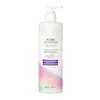Pacifica Acne Warrior Fighting Body Wash With 2% Salicylic Acid Versus Naturium The Smoother Glycolic Acid Exfoliating Body Wash
What's inside
What's inside
 Key Ingredients
Key Ingredients

 Benefits
Benefits

 Concerns
Concerns

 Ingredients Side-by-side
Ingredients Side-by-side

Salicylic Acid 2%
MaskingWater
Skin ConditioningCocamidopropyl Betaine
CleansingSodium C14-16 Olefin Sulfonate
CleansingAloe Barbadensis Leaf Juice
Skin ConditioningGlycerin
HumectantParfum
MaskingCitric Acid
BufferingPotassium Sorbate
PreservativeSodium Benzoate
MaskingPanthenol
Skin ConditioningAllantoin
Skin ConditioningSodium PCA
HumectantEthylhexylglycerin
Skin ConditioningNiacinamide
SmoothingCucumis Sativus Fruit Extract
EmollientMelilotus Officinalis Extract
AstringentHamamelis Virginiana Leaf Extract
Skin ConditioningSalicylic Acid 2%, Water, Cocamidopropyl Betaine, Sodium C14-16 Olefin Sulfonate, Aloe Barbadensis Leaf Juice, Glycerin, Parfum, Citric Acid, Potassium Sorbate, Sodium Benzoate, Panthenol, Allantoin, Sodium PCA, Ethylhexylglycerin, Niacinamide, Cucumis Sativus Fruit Extract, Melilotus Officinalis Extract, Hamamelis Virginiana Leaf Extract
Water
Skin ConditioningSodium Cocoyl Isethionate
CleansingGlycolic Acid
BufferingSodium Hydroxide
BufferingSodium Methyl Cocoyl Taurate
CleansingGlycol Distearate
EmollientLactic Acid
BufferingMalic Acid
BufferingPyruvic Acid
MaskingTartaric Acid
BufferingSodium PCA
HumectantPolyquaternium-73
Cocamide Mipa
EmulsifyingCocamidopropyl Hydroxysultaine
CleansingChondrus Crispus Extract
Skin ConditioningPolyquaternium-10
Glycerin
HumectantCaprylyl Glycol
EmollientDidecyldimonium Chloride
EmulsifyingMethylpropanediol
SolventPolyquaternium-80
CleansingCitric Acid
BufferingTetrasodium Glutamate Diacetate
Sodium Lactate
BufferingWater, Sodium Cocoyl Isethionate, Glycolic Acid, Sodium Hydroxide, Sodium Methyl Cocoyl Taurate, Glycol Distearate, Lactic Acid, Malic Acid, Pyruvic Acid, Tartaric Acid, Sodium PCA, Polyquaternium-73, Cocamide Mipa, Cocamidopropyl Hydroxysultaine, Chondrus Crispus Extract, Polyquaternium-10, Glycerin, Caprylyl Glycol, Didecyldimonium Chloride, Methylpropanediol, Polyquaternium-80, Citric Acid, Tetrasodium Glutamate Diacetate, Sodium Lactate
 Reviews
Reviews

Ingredients Explained
These ingredients are found in both products.
Ingredients higher up in an ingredient list are typically present in a larger amount.
Citric Acid is an alpha hydroxy acid (AHA) naturally found in citrus fruits like oranges, lemons, and limes.
Like other AHAs, citric acid can exfoliate skin by breaking down the bonds that hold dead skin cells together. This helps reveal smoother and brighter skin underneath.
However, this exfoliating effect only happens at high concentrations (20%) which can be hard to find in cosmetic products.
Due to this, citric acid is usually included in small amounts as a pH adjuster. This helps keep products slightly more acidic and compatible with skin's natural pH.
In skincare formulas, citric acid can:
While it can provide some skin benefits, research shows lactic acid and glycolic acid are generally more effective and less irritating exfoliants.
Most citric acid used in skincare today is made by fermenting sugars (usually from molasses). This synthetic version is identical to the natural citrus form but easier to stabilize and use in formulations.
Read more about some other popular AHA's here:
Learn more about Citric AcidGlycerin is already naturally found in your skin. It helps moisturize and protect your skin.
A study from 2016 found glycerin to be more effective as a humectant than AHAs and hyaluronic acid.
As a humectant, it helps the skin stay hydrated by pulling moisture to your skin. The low molecular weight of glycerin allows it to pull moisture into the deeper layers of your skin.
Hydrated skin improves your skin barrier; Your skin barrier helps protect against irritants and bacteria.
Glycerin has also been found to have antimicrobial and antiviral properties. Due to these properties, glycerin is often used in wound and burn treatments.
In cosmetics, glycerin is usually derived from plants such as soybean or palm. However, it can also be sourced from animals, such as tallow or animal fat.
This ingredient is organic, colorless, odorless, and non-toxic.
Glycerin is the name for this ingredient in American English. British English uses Glycerol/Glycerine.
Learn more about GlycerinSodium PCA is the sodium salt of pyroglutamic acid. It is naturally occurring in our skin's natural moisturizing factors where it works to maintain hydration.
The PCA stands for pyrrolidone carboxylic acid, a natural amino acid derivative.
This ingredient has skin conditioning, anti-inflammatory, and humectant properties. Humectants help hydrate your skin by drawing moisture from the air. This helps keep your skin moisturized.
Learn more about Sodium PCAWater. It's the most common cosmetic ingredient of all. You'll usually see it at the top of ingredient lists, meaning that it makes up the largest part of the product.
So why is it so popular? Water most often acts as a solvent - this means that it helps dissolve other ingredients into the formulation.
You'll also recognize water as that liquid we all need to stay alive. If you see this, drink a glass of water. Stay hydrated!
Learn more about Water